#Prairie Prickly Pear
Explore tagged Tumblr posts
Text

Opuntia macrorhiza / Prairie Prickly Pear on the Red Rocks Trail in Lakewood, CO
#Opuntia macrorhiza#Opuntia#cactaceae#Prairie Prickly Pear#prickly pear#Cactus#succulents#Native plants#Native flowers#Native cacti#Plants#Flowers#Cacti#Nature photography#photography#photographers on tumblr#Red rocks trail#Red rocks#Lakewood#Lakewood CO#lakewood colorado#Colorado#🌺🌻
31 notes
·
View notes
Text
saw wild native illinois prickly pear cactus today. they were living it up on a prairie preserve flowering flourishing not a worry or typical desert in sight. i vividly remember this being a trick question on a kahoot activity in an entry-level bio class in college and I got it wrong because I said it was not possible, but folks…. it can happen
#not to blow up anybodys native midwestern prickly pear viewing spot#but it was the thomson fulton sand prairie nature reserve#dude. so much of it#I think that in mowing a couple feet on either side of the trail they sent cactus bits flying and made even more cactus flourish#anyway my mom wanted to go there bc she heard there were lizards there and we went and we did indeed see lizards.#they were six lined racerunners and they were very small and beautiful and fast#cacti
649 notes
·
View notes
Text
The (Real) Stardew Valley Farm Update 2024
I’m wrapping up my third year trying to grow everything from Stardew Valley in our yard, with substitutions as needed, preferably with Midwest USA native plants.
I’m continuing to battle the invasive plants (why won’t the honeysuckle and thistles stop?????), beg for truckloads of woodchips (Google decided our address isn’t real anymore), and deal with a body and brain that makes going outside impossible sometimes (the past two years have been rough medically). But despite all of that I still managed to make a ton of progress!
Here’s how things stand as of now. If you’re looking back at previous posts you might notice some differences, but that’s mainly because things I planted died (drought + medical crises don’t bode well for newly established plants). I’ve also added the additional crops from the new update.
2021
Amaranth - Native white amaranth
Grape - Native riverbank grapes (so many grapes). I’m hopefully going to successfully propagate some cuttings from the neighbor’s green cultivated variety
Dandelion - Obviously
Maple Tree - Native silver, red, and sugar maples
Pine Tree - Douglas fir
Apple Tree - Three old apple trees of different varieties in very rough shape. I’ve been working to prune them up and two are looking a lot better. I’d love an Enterprise apple tree at some point
Coffee Bean - Chicory (a naturalized plant commonly used as a coffee substitute)
Salmonberry - Native black raspberries since salmonberries aren’t from around here, although I really want to add raspberries of various colors in the future
Starfruit - Native wood sorrel
Cave Carrot - Queen Ann’s Lace, AKA wild carrot
2022
Kale
Rhubarb
Strawberry - Both cultivated and native
Tulip
Radish
Tomato
Eggplant
Fairy Rose - Native prairie rose
Cranberries - Native cranberry viburnum
Orange Tree -Native persimmons, which produce orange fruit
Daffodil
Spring Onion - Native nodding onions
Spice Berry - Native spicebushes
Wild Plum - Native plums
Crocus
Cherry Tree - Native black cherries and nonnative bush cherries
Banana Tree - Native pawpaws, which are also known as Indiana bananas
Sweet Gem Berry - Native Juneberry (Downy Serviceberry)
2023
Garlic - Native wild garlic
Blueberries - I planted three varieties and only one survived. Don’t shortcut your bed preparation, friends
Wild Horseradish - Not wild, but contained with my mint
Hops - Teamaker hops which is good for tea since we’re not alcohol fans
2024
Blue Jazz - Native Ozark Bluestar
Beets
Apricot Tree - Native passionflower vine, also known as wild apricot
Sunflower - Both native and non-native sunflowers
Pumpkin
Cactus Fruit - Native prickly pear cactus
Melon - Cantaloupe
Oak Tree - Native dwarf chinquapin oak, which took me forever to get
Hot Pepper
Palm Tree/coconut - Native palm sedge
Poppy - Native purple poppy mallow, after other native poppies failed. I still want to grow bread seed poppies, though
Corn - Tried some gorgeous colored corn and popcorn that didn’t grow great but they did grow!
Green bean
Hazelnut - They’re supposed to be easy to grow but they do not like me. Third time’s the charm, right?
Carrot
Summer squash
Powder melon - I decided to do honeydew melon because it’s kinda powdery and I don’t really have any other ideas
Planned for 2025 and beyond
Potato
Pineapple - White strawberries (pineberries)
Winter Root - Hopniss, a native root vegetable
Red Cabbage
Artichoke - Native Jerusalem artichokes
Yam
Bok Choy
Leek
Fiddlehead Fern - Ferns do not like me
Blackberry
Crystal Fruit - Probably honey berries, which produce fruit earlier than anything else
Ancient Fruit - Native Aronia berries. They’re blue(ish) and have lots of antioxidants so you live to be ancient
Tea Leaves - Native New Jersey Tea bush. The previous ones were murdered by rabbits
Mango Tree - I thought one of our pawpaws was a variety called mango but I was wrong
Ginger - I want to try growing native wild ginger again
Rice - Native rough-leaved rice grass
Wheat - I have some gorgeous ornamental blue wheat seeds
Summer Spangle - Possibly native prairie lily? I was unsuccessful growing it from seed this year but maybe in the future
Parsnip - I can’t get them to germinate to save my life but one day I will be successful
Sweat pea
Holly - Native winterberry holly
Mushrooms - I'm just gonna ignore varieties and try some plugs or similar
Peach - Vine peach. It’s a melon, and more doable than a tree
Mahogany Tree - I think I’ll resort to mahogany nasturtiums
Broccoli
Pomegranate Tree - I could try Russian pomegranates?
Taro Root - I would have to plant it in pots
Snow Yam - Not actually a yam but maybe native sweet potato vine?
Qi Fruit - Very creepy, not sure what to do with this
Over halfway there! If anyone has suggestions for plants please let me know because I’m still stuck on a few and very open to alternatives.
In other news, I’m making Stardew Valley Fair displays with cross stitch patches for each of the items I’ve added that year. I’ll have to post pics of those at some point.
#the (real) stardew valley farm#the habitat ring#gardening#stardew valley#don’t be a petaq grow native plants#I am making the best life decisions and this is definitely worth it
22 notes
·
View notes
Text
My Garden Flowers Part 4
All photos mine. The Pennsylvania pellitory is edited for because the plant app I took the photo in washed it out. The scarlet bee balm is edited for colour because that old phone's camera sucked.























In order of appearance:
091. Pennsylvania Pellitory (Parietaria pensylvanica) A common garden weed, but as it's native it can stay in some places.
092. Perennial Flax (Linum perenne) In spite of the name she sadly didn't come back or reseed. Shame because she looked really nice in that area. Oh well. I'll have to try in another spot.
093. Showy Tick-Trefoil (Desmodium canadense) She tricked me! I thought she hadn't made it as she hadn't come up by late June so I got another one and put her in a different area...only for this one to come up. And if you're thinking, oh, she's just a late bloomer, I should have waited, well, she came up in May this year. Because of course she did.
094. Virginia Mountain Mint (Pycnanthemum virginiana) She smells like something you'd want to season steak or something with and would probably do very well at that but I've never cooked a steak before. Maybe I'll try her in pesto some day.
095. Devil's Tongue (Opuntia humifusa) She flowered for the first time last year and is flowering again this year!
096. Fragile Prickly Pear (Opuntia fragilis) Not pictured as she hasn't flowered yet. She's still quite little. I might break off a piece of her to try growing in that really tough spot. If she can survive summer to winter in a pot, surely that area shouldn't be too harsh for her.
097. Thrift Seapink (Armeria maritima) She's tough enough to survive winter in a pot and did so for three years, but last winter was apparently too much for her. Again, I think it was just too dry. She was pretty much only happy there in the spring and fall, though, so maybe it's just as well. The new one I planted elsewhere seems happy in all seasons.
098-099. Lance-Leaved Tickseed (Coreopsis lanceolata) Usually only the cultivars have those red markings! I'm assuming there's been some cross-pollination with other gardens because I did not plant that. My tickseeds are all straight amber. Unless she independently produced the colour on her own as a sport. Interestingly enough, none of them are showing that colouration this year.
100. White Sagewort (Artemisia ludoviciana) I wasn't actually supposed to have this one. I'd ordered the less aggressive A. frigida, but oh well. Maybe she'll attract American lady butterflies some year. Not pictured as she hasn't flowered yet. She smells like something you'd use to season stuffing.
101. Blue-Eyed Grass (Sisyrinchium angustifolium) After several attempts in different areas, trying my hardest to follow what the information online said she would need, but somehow failing, this one at last seems to be doing fine.
102. Dotted St. John's Wort (Hypericum punctata) I didn't plant that. Either a gift of the wildlife or a dormant seed came to life when I removed the grass.
103. Roundhead Bushclover (Lespedeza capitata) Another one I've had several attempts with, but she seems to like it there.
104. Curlycup Gumweed (Grindelia squarrosa) Flowered nicely that year and I thought she didn't reseed because she didn't come up last year but there is a plant this year! It's good to remember that seeds can lie dormant for some time. :)
105. Upright Prairie Coneflower "Mexican Hat" (Ratibida columnifera) This is a cultivar and has since passed away during the winter.
106. Rocky Mountains Bee Plant (Cleomella serrulata) She reseeded for several years but apparently not this one. Hopefully they're just skipping a year and will come up next spring. If not I'll have to attempt a different area. Anyway, pretty much the whole plant is edible with preparation, and lots of insects love the flowers.
107. Spotted Horsemint (Monarda punctata) Beloved of many insects. Sometimes I just like to sit next to her and watch the activity.
108. Wild Black Sweet Tomato (Solanum ptychanthum) She began as a weed on this property, but not anymore. She is a welcome part of my native garden with her wonderful fruits in the summer.
109. Common Sunflower (Helianthus annuus) The wild type this time, but no evidence of reseeding this year. :(
110. Alpine Rock Cress (Arabis alpina) She flowers in April before most trees have even blossomed.
111. Field Chickweed (Cerastium arvense) By the time I got to plant her in the fall some years ago, I was sure she'd die over the winter. She didn't but struggled through the warm months. But she managed to bounce back the following spring and makes a nice little carpet now.
112. Yellow Wild Indigo (Baptisia tinctoria) Not pictured as she hasn't flowered yet.
113. Butterflyweed (Asclepias tuberosa) Finally decided to flower this year! She is the only orange species of milkweed native this far north.
114. Upright Prairie Coneflower (Ratibida columnifera) The wild type. Didn't like that spot in the winter either, so I'm trying a different area this year.
115. Fringed Blue Aster (Symphyotrichum ciliolatum) Not the most colourful or compact, but makes a nice spray of pale blue violet over her dark green foliage.
116. Bluestem Goldenrod (Solidago caesia) Not pictured as she hasn't flowered yet, but she's likely to this year.
117. Black Walnut (Juglans nigra) She's been on the property long before I got here. Not pictured as I haven't gotten any pictures yet since she is very tall.
118. Field Pussytoes (Antennaria neglecta) Compact and low-growing foliage create a mat, with these delicate stems poking out with what looks like kitten toes that pass for the plant's flower.
119. Aster (Symphyotrichum) I don't know what she is yet, but she decided to take up residence with my pussytoes and I guess that's okay. Haven't gotten pictures of the flowers yet.
120. Dotted Blazing Star (Liatris punctata) Not pictured as she hasn't flowered yet.
#blackswallowtailbutterfly#my photos#photography#my garden#garden flowers#native plant gardening#Parietaria pensylvanica#Linum perenne#Desmodium canadense#Pycnanthemum virginiana#Opuntia humifusa#Armeria maritima#Coreopsis lanceolata#Sisyrinchium angustifolium#Hypericum punctata#Lespedeza capitata#Grindelia squarrosa#Ratibida columnifera#Symphyotrichum ciliolatum#Antennaria neglecta
8 notes
·
View notes
Text
@katblu42 wrote: “I know practically nothing about Texas, other than it is big, and in the South of the USA. It seems to be portrayed as having fairly warm weather . . . but as large as it is, does it have regions of varying weather patterns? And in a similar vein, are there various areas of diverse vegetation/fauna?”
••••••
In short, yes. I live in West Texas and mom in Southeast (about 500 or so miles apart), and we can have essentially two seasons. It can rain there and be bone dry here, and sometimes in the winter she asks me the temp so she can prepare the next day.
And it’s no exaggeration some parts of the state you can experience at least 3 seasons in the same day. I’m personally lucky in that I seem to have adapted to this particularly go here, which it’s frequent 2 seasons a day right now, but I get funny looks being in short sleeves in cooler weather because of it.
•••••••
Vegetation/fauna is definitely diverse. If I travel from home to Mom’s, in that 8 hour drive I go from:
• a flat area where most trees that aren’t mesquite were planted by settlers (you can tell where a house is/was based on clusters of trees), that grows cotton and feed if they aren’t an oil town
• area with mesas and wind turbines after leaving the Caprock, another ironically heavier oil area. The turbines are increasing to the point I joke they’re “Don Quixote’s nightmare.
• areas with thicker areas of trees that are shorter, oddly at times more prickly pear cactus, and bigger cities,
(This varies if I take the longer route - uncommon but I will in December to run a different St. Jude race - through Boerne/San Antonio where you go through the mesas and rolling plains again in the middle of the state, and unfortunately experience 40 mins. of cell phone dead zone. It’s bad to the point it’s LEGAL to go 80 mph to get through it)
• heavily wooded area and gentle hills.
And then if we go to Galveston or Corpus Christi there’s some marshy areas and then the coast.
The marshiest area is around La Porte I think, which is where the battle of San Jacinto was and the Texas fighters used this to an advantage.
••••••
Wildlife varies. I see more wild turkey and pheasant here than east coast. I’ve seen a few roadrunners but they seem more prevalent in the Palo Duro Canyon.
Prairie dogs are far more common in west Texas. Amarillo’s minor league team’s mascot is Sodpoodles (a nickname) and Lubbock has one park dedicated to the black tail prairie dogs.
Anyone watching them I’d say don’t walk close: their town system underground makes it dangerous to walk lest you fall through a hole.
I definitely see more deer near moms along with raccoons. Skunks more often here: in the summer I must walk the cemetery in full daylight, not dusk as they seem to like living there more. (Just clarifying for folks: where I am the cemetery is the safest place to walk due to bad traffic and has a very high visibility).
Snakes are definitely a big issue all around. For the poisonous ones, West Texas more rattlers and coral while East copperheads and water moccasins (though up here we’ll see some copperheads).
Coast we see a lot of sea turtles nest there, particularly Kemp Ridley. There’s a lot of hatching ceremonies in the year where the state protects the turtles until they waddle into the Gulf to give them a fighting chance to survive.
I’m sure there’s even more than this, but it’s more of I’ve experienced here
Thanks for the ask.
15 notes
·
View notes
Text
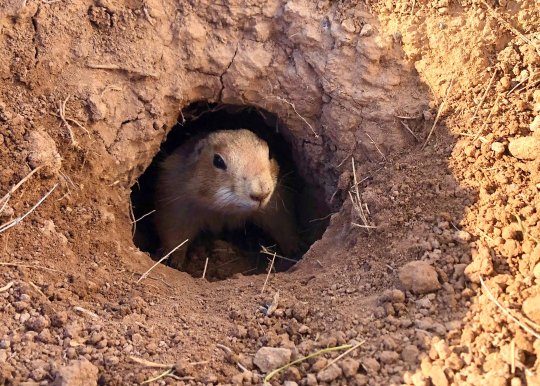
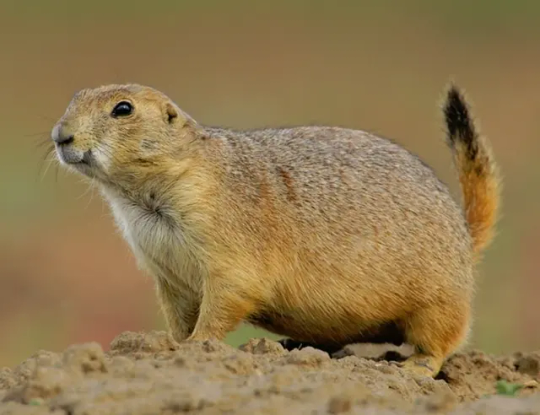
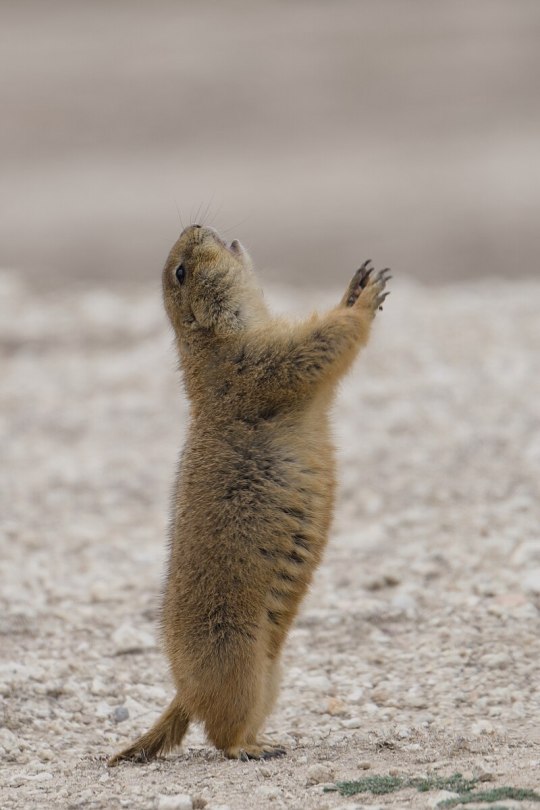
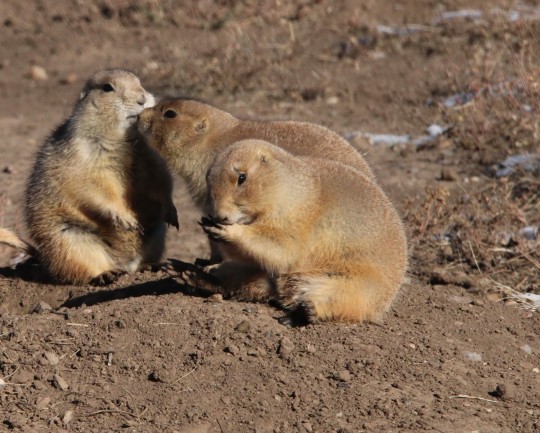


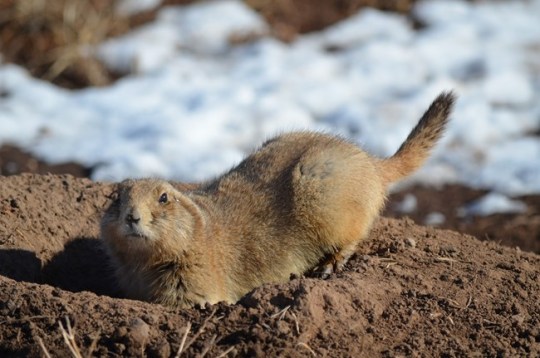

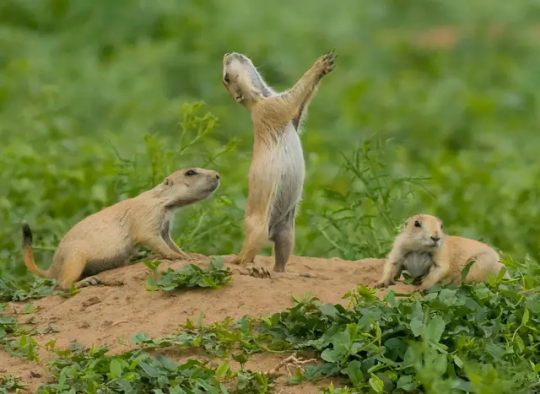
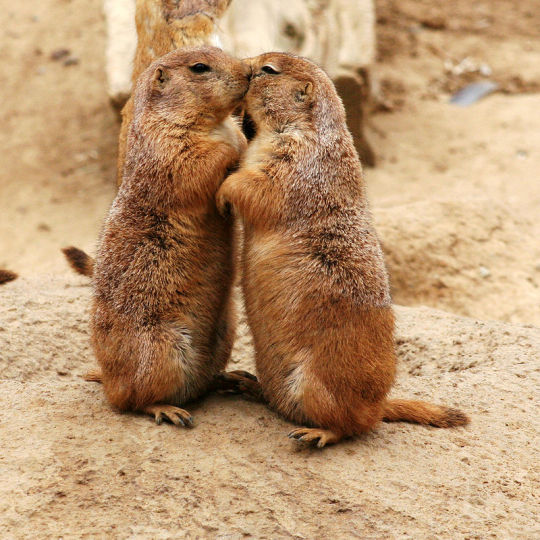
Cynomys ludovicianus, better known as the black-tailed prairie dog is a rodent of the family Sciuridae and one of five species of prairie dog ( the others being the white-tailed, Gunnison's, Utah, and Mexican prairie dogs). They are native to the Great Plains of North America found in the Great Plains of North America from southern Saskatchewan and Alberta Canada to Northern Chihuahua, Mexico and from as far east as the US state of Iowa to as far west as Arizona. Black-tailed prairie dogs are highly social animals that live in large "towns" in the wild that may contain thousands of individuals. Towns may be subdivided into two or more wards, based on topographic features, such as hills. Wards are usually subdivided into two or more coteries, which are composed of aggregates of highly territorial, harem-polygynous social groups. A coterie typically consists of a dominant male, 3-4 adult females, their young pups, and yearling juveniles. Individuals within coteries are amicable with each other and hostile towards outside individuals. These rodents are famous for creating elaborate burrow networks which serve as refuges from the external environment and are one of the most important features of their colonies. Burrows are used for breeding, rearing young, and hiding from predators, and are maintained from generation to generation, and serve as stabilizers on the physical and social aspects of the colony. A black tailed prairie dogs diet is primarily comprised of grasses, flowers, forbs, and sedges along with occasionally thistles, roots, worms, grasshoppers, bushes, and cacti particularly prickly pear. Black tailed prairie dogs get the majority of there water from there food. Black tailed prairie dogs are themselves eaten by coyotes, american badgers, bobcats, foxes, eagles, hawks, prairie rattlesnakes, and black-footed ferrets. Reaching around 17 to 21 inches (43 to 53cms) in length and 1.5 to 3lbs (0.68 to 1.36 kgs) in weight (with males being slightly larger than females), black tailed prairie dogs sport rounded heads, compact bodies, and long claws used for digging. The coat is sandy-colored fur with paler coloration on the underside, and a black tipped tail hence there common name. The breeding season occurs from late February through April, after a 33 to 38 day pregnancy a mother black tailed prairie dog will give birth to a litter of 1 to 8 pups. Pups do not open their eyes until 30 days after birth. They remain nursing underground for the first 7 weeks of their life. Pups are weaned very soon after they first emerge from the burrow and start eating grasses. Females within the group all help care for the young. Black tailed prairie dogs typically reach sexual maturity at around 12 to 15 months of age, whilst females often remain with there natal group for life males set off to start there own territory and coterie. Under ideal conditions a black tailed prairie dog may live up to 8 years.
#pleistocene pride#pliestocene pride#cenozoic#black tailed prairie dog#prairie dog#rodent#animal#facts
6 notes
·
View notes
Text
Alaska: Igloo, Kodiak bear, Iditarod sled dog race, Denali
Hawaii: pearl harbor, pineapple
washington: Space Needle, apple, mt st helens, rainier national park
oregon: roses, lighthouse, crater lake, oregon trail, hiking
california: redwood tree, white water rafting, gold, golden gate bridge, silicon valley, yosemite national park, wine country, sierra nevada mountains, hollywood, joshua tree
nevada: silver, las vegas strip, hoover dam
idaho: gemstones, potatoes
montana: rocky mountains, glacier national park, grizzly bear, bison
wyoming: yellowstone national park, old faithful geyser, bucking bronco
utah: great salt lake, zion national park, skiing
arizona: lake mead, grand canyon national park, montezuma castle, turquoise, saguaro cactus
new mexico: pueblo, yucca plant, carlsbad caverns
colorado: rocky mountain national park, columbine flower, elk
north dakota: oil, wind energy
south dakota: crazy horse memorial, the badlands, mount rushmore
nebraska: chimney rock, bald eagle, train
kansas: tornadoes, dodge city, sunflower
oklahoma: tomato, wheat, osage shield
texas: cattle, prickly pear cactus, oil refinery, the alamo, NASA Johnson space Center
Minnesota: lake of the woods, wolf, deer
iowa: prairie grass, corn
missouri; Hog, gateway arch
arkansas: razorback hog, banjo
louisiana: crayfish, mardi gras, jazz music
wisconsin: dairy
illinois: Willis tower, tractor, lincoln
michigan: copper, iron ore, automobile manufacturing, motown
indiana: Car
ohio: Rock and Roll Hall of Fame, tires
pennsylvania: street mill, liberty bell
new jersey: constitution
maryland: blue crab
virginia: mount vernon
north carolina: wright brothers national memorial, tobacco farm, great smoky mountains national park, appalachian mountains
south carolina: fort sumter
georgia: peanuts, peach
florida: oranges, kennedy space center, alligator, everglades national park
alabama: cotton, civil rights movement
mississippi: magnolia
tennessee: country music
kentucky: horse racing
west virginia: coal
new york: apple tree, financial market, statue of liberty
massachusetts: american revolution
vermont: maple syrup
new hampshire: fall colors
maine: acadia national park, moose, lobster
And don’t make me repeat it!!!!!!!
7 notes
·
View notes
Text
The residents of the Swiss canton of Valais are used to seeing their mountainsides covered with snow in winter and edelweiss flowers in summer. But as global heating intensifies, they are increasingly finding an invasive species colonising the slopes: cacti.
Authorities say cactus species belonging to the genus Opuntia, or prickly pears, are proliferating in parts of Valais, encroaching on natural reserves and posing a biodiversity threat.
“A lover of dry and hot climates, this invasive and non-native plant is not welcome in the perimeter of prairies and dry pastures of national importance,” the municipality of Fully in the Rhone valley said in a press release announcing the uprooting campaign in late 2022.
Opuntia species and similar cacti have also proliferated in some of the hills around the capital of Valais, in Sion, where estimates suggest Opuntia plants now make up 23-30% of the low vegetation cover. Their presence has also been reported in neighbouring Alpine regions, including Ticino and Grisons in Switzerland, and the Aosta valley and Valtellina in Italy.
“In some parts of Valais, we estimate that the cacti can occupy one-third of the available surface,” says Yann Triponez, a biologist who works in the canton of Valais’ nature protection service. He says Opuntia have been present in Valais at least since the late 18th century, when it was imported from North America.
But authorities believe that a warmer climate in the Alps, allowing for longer vegetation periods, and the diminishing snow cover might be creating the ideal conditions for them to spread.
“These species bear -10C or -15C without any problem,” says Peter Oliver Baumgartner, a retired geology professor with a longstanding side interest in botany who has been commissioned by the canton to study and write a report on the plants. “But they want to be in a dry place and don’t like snow cover.”
Snow is becoming rarer at lower altitudes, even in the Alps. According to Meteo Swiss, the number of snow days under 800 metres of altitude in Switzerland has halved since 1970. A recent study published in Nature Climate Change said snow covers the Alps for about a month less than historical averages and called the situation “unprecedented in the last six centuries.”
Temperatures across the range have been rising twice as fast as the global average, and average temperatures in Switzerland are already 2.4C warmer than 1871-1900 averages. “If you look at climate change reports,” Baumgartner says, “the curves for Switzerland are almost as steep as for the Arctic.”
Nine species have spread on sunny, south-facing slopes below 700 metres of altitude, where they compete with endemic and sometimes threatened species. “Valais is one of the biodiversity hotspots in Switzerland,” says Triponez. “We have about 3,000 species of plants in Switzerland, and some 2,200 are in Valais.”
He says authorities are worried by the cacti’s spread to natural reserves and protected areas. “When you have these cacti, nothing else grows,” says Triponez. “Each pad covers the soil and prevents other plants from growing through.”
Baumgartner says that only four of the nine Opuntia species in Valais represent a threat to local ecosystems, particularly in areas with acid or neutral soils, which account for one-third of the valley’s south-facing slopes.
#alps#alpine plants#invasive species#prickly pear#cactus#cacti and desert plants#global warming#climate change#europe#Switzerland
52 notes
·
View notes
Text
Flowers (and more) Friday
Thanks to @carolrain for the tag! Here are some flowers and other nature-y things from my summer.










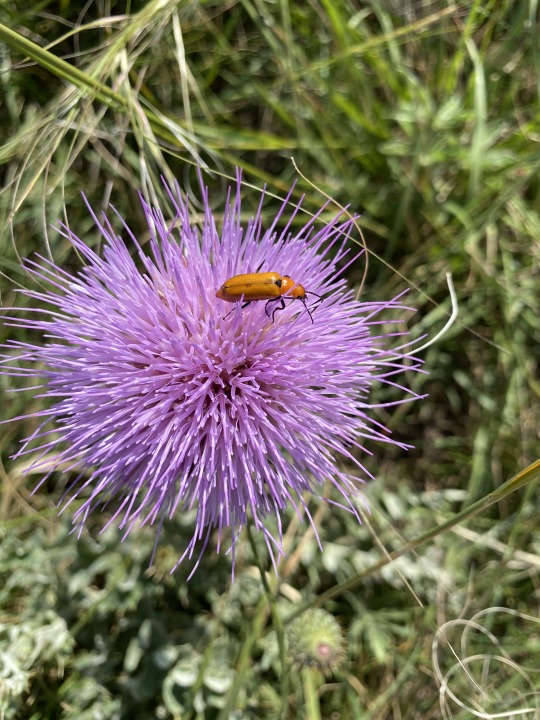

Top row: Three-flowered avens in seed, Border Goldthread (a rare species, I found the only known local location this summer, so I'm stoked about it), Mountain Ladyslipper
Second row: Rock formations at Red Rock Coulee, White spruce cones, Prairie violet (a spring favourite)
Third row: Scarlet bee blossom, Butte marigold, Plains prickly pear cactus
Bottom row: Mountain cottontail, beetle on a wavy-leaved thistle flower, Red bee balm from my garden
I also have to second @carolrain's recommendation of the Seek app and would like to add recs for the Merlin app and for iNaturalist.
Tagging @stereopticons @weathereyehorizon @missgeevious @flowertrigger @dinnfameron and anyone else who wants to share some nature pics from their summer
6 notes
·
View notes
Text
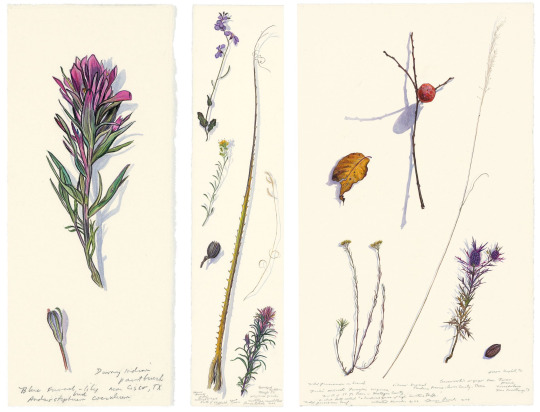
Detail of Downy Indian Paintbrush, Texas Bluebonnet, Prickly Pear Cactus, Ozona and Marfa, Texas (Specific Objects No. 2), March 2023; Sotol Leaf and Paintbrush, Trans-Pecos, Marfa, West Texas, March 2023; Wild Persimmon and Eryngo, Cross Timbers, Thomsen Prairie, Montague County, Texas, November 2022; and New England Blazing Star, Chinkapin Oak, Fen Grass of Parnassus, Bethel, Connecticut, August 2023 Art by James Prosek.
2 notes
·
View notes
Text
South Saskatchewan
Next morning, I was super-efficient in packing up and left sharp at 7.45am (I've become even better at early departures in the Rockies, simply to avoid the crowds 🥴) as I had a long drive to do; over 600km to my next camping spot... Not sure I completely had thought this through when I booked it, but think I was lured by the 1-hour jump back in time when crossing into Saskatchewan, although the actual driving time stays the same of course!! 🤔
First Gmaps direction; turn left in 361km.... love it, those large-distance roads in Canada! 🙃 I was now officially on the Red Coat Trail but different to other provinces, I never saw any plaques or tourist info signs so I still don't really understand what it's about... I presume something with the army traveling west during the new frontier?? Now, it's just endless fields and sky which are pretty in their own right... Although I love my trees and forests, there's something special about this massive expanse of agricultural lands, a testament to human's ability to control the land. I did feel cheated, as the "Land of Living Skies" was yellow-grey both below and above the horizon with smoke turning everything dull... such a shame! On the way, there's really not much to see apart from the rare sunflower field 🤩, modern-day grain stores, cows and surprisingly lots of nodding donkeys that pump oil from the ground!
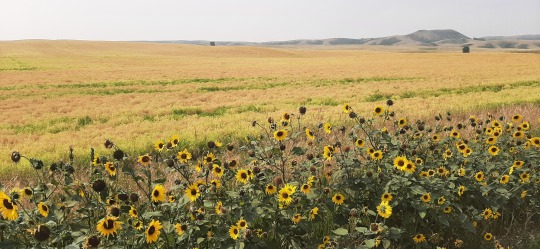

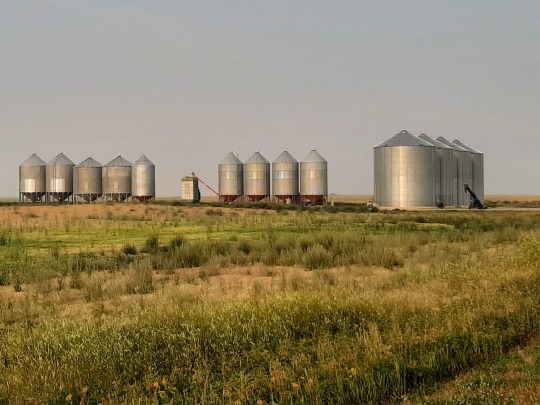
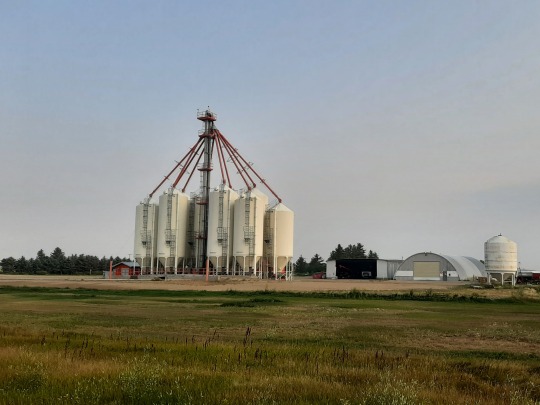

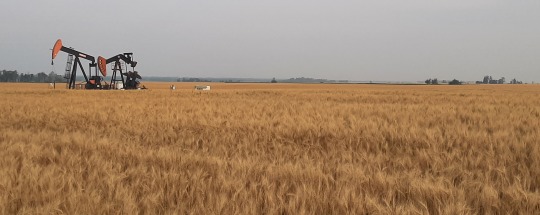
Close to half-way the province, I veered further south towards the US border onto gravel roads to see Castle Butte, a 200ft-high knoll left in the landscape during the Ice Age (not sure I trust that info, as I thought buttes are of volcanic origin). Looming high above the flat prairie land I tried to climb up it (where other people already were so I was not completely stupid yet) but it got too steep for my non-hiking shoes and then instead of coming down on my butt as I should have, I tried to walk it and ended up running at full speed down the slope... I got really extremely lucky I didn't fall and break any/all body parts!! 😳😳 I did end up semi-twisting both ankles which I still feel 2 weeks later, but instead of complaining I am grateful that that was the worst of it! Phew...


The adventures of the day didn't stop with that because a bit later I ran over and killed a duck! 😫 With lots of dark skid marks on the gravel, I only realized too late that there were 4 full-sized ducks sitting in the middle of the road and although I braked as much I safely could, I had no choice than to go over them and hope they all fit between my wheels... 3 survived (likely with a heart attack!) and one didn't. I've had very little roadkill in the 20+ years driving, and definitely nothing as big as this so that was quite upsetting!
My mood improved however when I arrived at Grasslands National Park, which consists of two blocks some 170km apart; the east block that I visited first protects a vast expanse of badlands, whereas the west block where I was camping that night represents Canada's largest tract of untouched native prairielands (which covered most of North America's central region until the settlers came ranching & farming). I'm trying not to overkill with pictures but both areas were very very pretty and I would urge anyone to make a trip out here!
On the east side, there's a few hikes but it was so hot that I simply drove along the Badlands Parkway with interpretative signs explaining the geology and the natural & human history of the area. The badlands seem at first glance quite monotone but then I discovered flowers, prickly pear cacti, gophers (ground squirrels of which I had already spotted lots on the road) and even a pronghorn antilope!
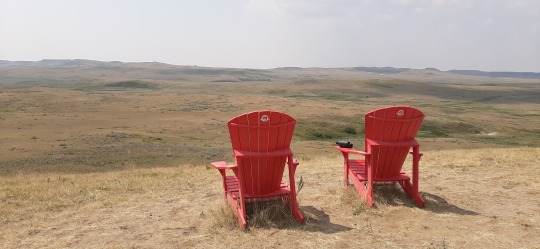
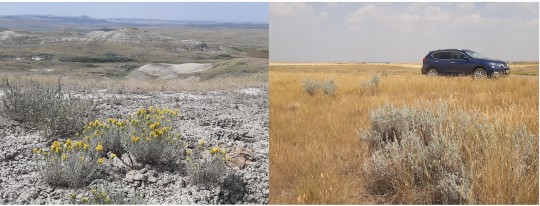

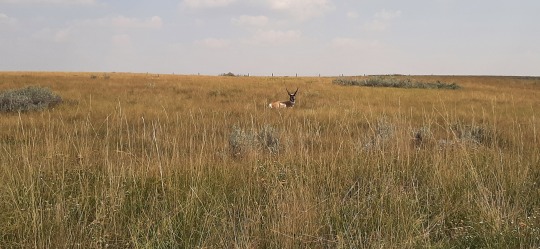
The clouds pushed by the wind kept changing the light patterns, highlighting in turn different hills, so it was great to sit for a while in a red chair and see the scenery constanly change.

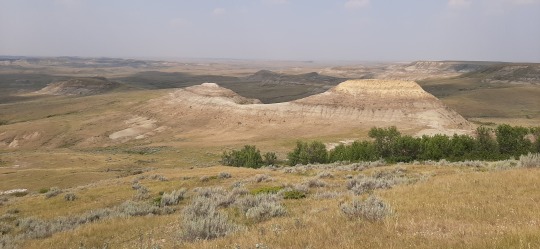

Hot and tired, I made the trek to the other block passing enroute another grain elevator, after which I set up camp on the beautiful prairie without a single tree (with a fence though to protect against the bison)! My pic of the sunset doesn't do it justice, but you can imagine how pretty the sky was, and as this is a dark sky preserve, I stayed up late (after midnight, which doesn't happen often anymore 😜) to watch the Milky Way in its full glory.
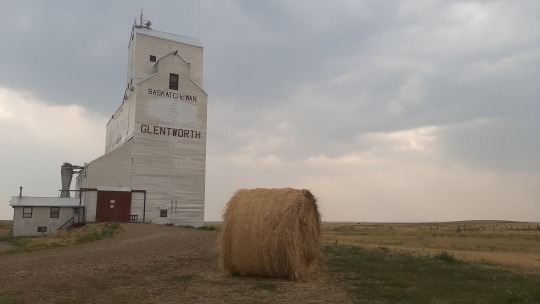

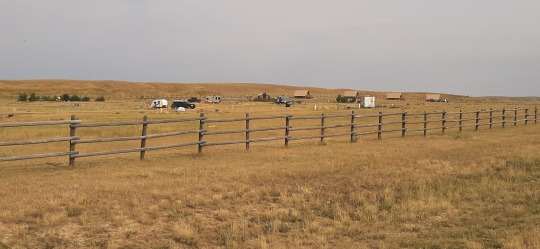
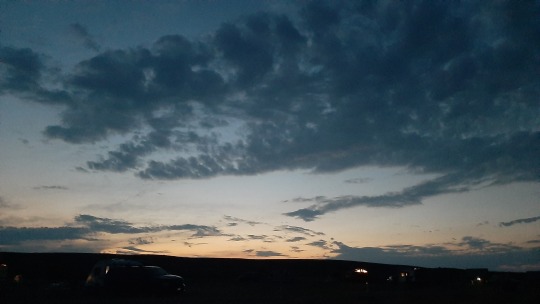
The next morning, I had a clear task; prairie dog and bison hunting, which are the two key species of the park. A gopher (top left pic) had already been running all morning around my site (he shouldn't have built his hole next to the firepit), so when I spotted the first prairie dog (top right pic) in one of the park's colonies or "dog towns" I was a bit confused as they looked the same to me! 😂 Turns out the prairie dogs are about twice the size and much more afraid of humans, although they loved eating the dead bugs from my car bumper and tires 😍 which meant that although it was impossible to get up close while walking as the first prairie dog would bark to warn the entire colony and then all disappeared, they had no problem with the car being close to them... funny how humans impact nature in weird ways sometimes!
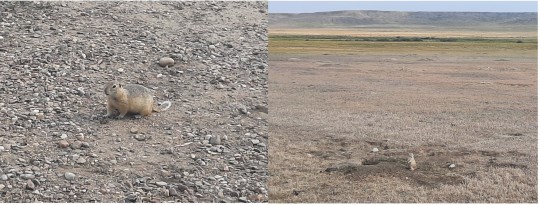
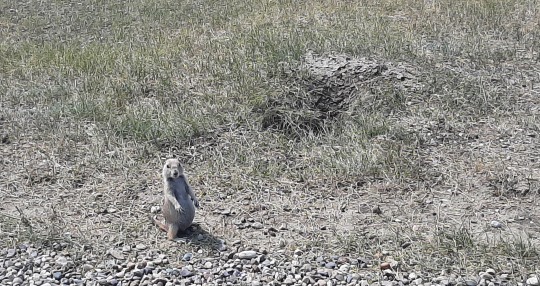
The bison were more elusive, as they truly don't like people, and although a herd of 500 of them is maintained in the park (with surplus animals being exported to other parks for reintroduction), the enclosed area is so large for them to roam in that they have plenty of places to hide. So I slowly made my way through the park with my binoculars on hand, learning along the way about a homestead that had managed to ranch cattle for a few years but then had to abandon because it was simply too hard to survive on the barren land, the different native grasses that make up the prairieland, a bison rubbing rock and a stone tipi ring, all the while enjoying the views.
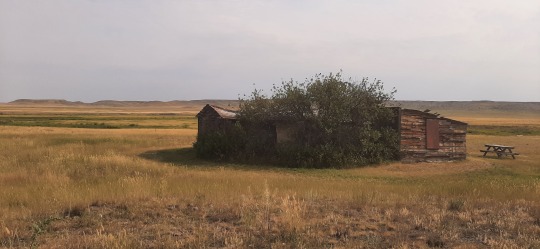

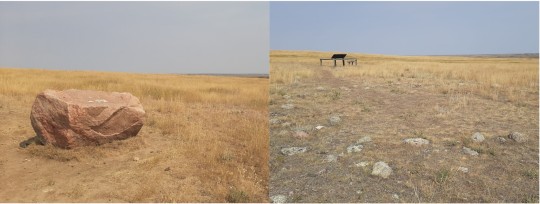
And then finally, when I had given up and was enroute to the village to get gas, I first saw a lone bison chugging through the grass, and then at the outermost corner of the enclosure, suddenly there was a group of 40 bison, including a few calves, that were grazing and rolling in the dirt. I promise I could see them much clearer in my binoculars than the little black specks in the picture! 😁

By the time I got to the village a massive rainstorm broke out so good reason to drop by the visitor centre and confirm it was a golden eagle (much bigger than bald eagles) that I had seen on a pole. I first didn't understand the gas "station" set-up as you needed to pull some levers to get it going, but finally managed to fill up the car once more.
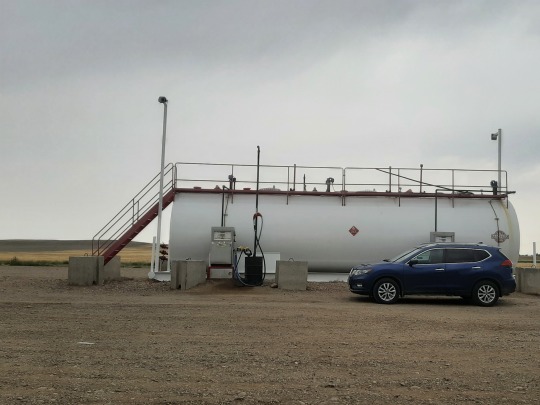
That evening, the skies blackened suddenly with a thunderstorm and the wind was so strong that the tent started sliding away (the neighbour's did blow away) so I threw in as many stones I could find, parked my car in front of the tent to form a bit of a windshield and waited it out in the car... no way I was going to stay in the tent on this flat land! Luckily the storm passed quite quickly after which I had a drink with my neighbours to laugh it out, but I did end up sleeping in the car (for the first time and quite comfortably!) as rain came & went with some more lightning in the night.
When I drove off in the morning towards the Alberta border, I finally got the promised Living Skies Land with blue skies and golden fields, seeing the Prairies in all its hues 😊 I also saw another (the same??) herd of bisons on the way out of the park as well as another smaller golden eagle and several antelopes 😍
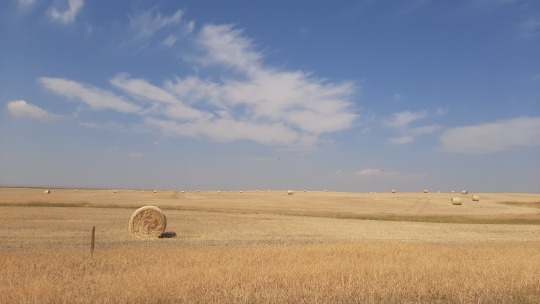
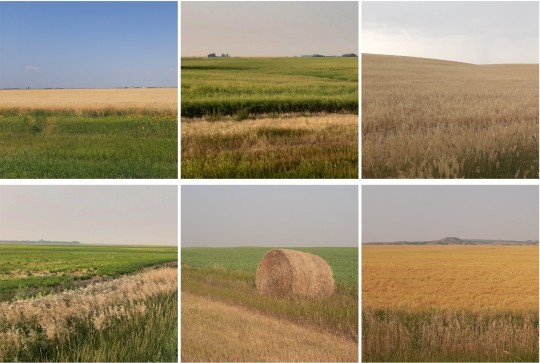
After a relatively short drive, I arrived at the Cypress Hills Interprovincial Park, which straddles the border between Saskatchewan and Alberta, consisting again of two blocks. Although I had planned again to visit the eastern block first and camp in the western one, a staff member pointed out that I was actually staying in the eastern block so that saved me another 1.5 hours drive! 👍 The park is unfortunately not very natural and has been developed as a resort with mini-golf, golf course, swimming pool etc so I was a bit disappointed. The nature that there is, is being protected because it's on a hill standing 500m above the plains so it was not glaciated and has therefore unique plant life (including trees) that doesn't occur anywhere else in the region but they haven't done a good job at protecting it! I had great internet at a viewpoint so ended up sitting on a bench there for 4 hours booking my next set of accommodations 😃 while occasionally hearing loud grunting lower on the hill which I presume was an angry moose so I didn't have any urge to go explore further!
Next day, I would be driving into Alberta, so this was Saskatchewan for now until I return further north on my way back. Adieu!

Wildlife: 1 coyote & 1 deer (Red Coat Trail), 100+ ground squirrels (gophers), 100+ prairie dogs, 43 bison in the afternoon and 50 bison in the morning, 2 golden eagles, 2 ferruginous hawks, 1 deer, 5 pronghorn antilopes (Grasslands), 3 red-tailed hawks & 3 deer (Cypress Hills)
SUPs: none
Hikes: no real ones, just lots of little sidetrips to viewpoints
Distance driven since the last map (I'm losing track of the weeks 😉 but it's been a while all the way from Sleeping Giant): 1,925 km
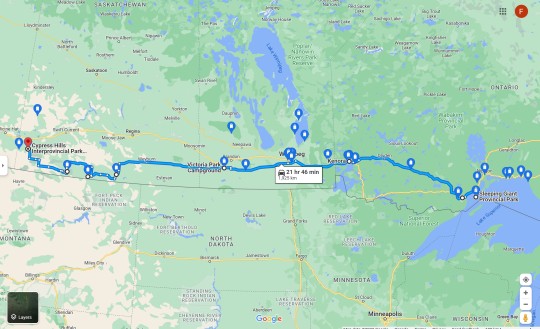
3 notes
·
View notes
Text
November 3, Day 307/308
Day 307 2015

Thanks, Walmart, I'm inspired.
#holidaycards #walmart #magicmikexxl #smh #picoftheday #project365 #day307
Day 308 2016

Crafting for kindergarten
#craft #art #create #november #orange #red #yellow #shadesoffall #picoftheday #project365 #day308
Day 307 2017

Found a whole bag of newspaper plastics on my walk...
#walk #outdoors #plastic #trash #pickitup #throwitaway #notthathard #everydayisearthday #nastytrash #november #picoftheday #project365 #day307
Day 307 2018

Red vine
#fall #autumn #vine #nature #outdoors #flora #red #leaves #fallleaves #november #picoftheday #project365 #day307
Day 307 2019

Spent my extra hour today processing a few images. Enjoy
#light #color #playtime #frozen #ice #flowers #mum #chrysanthemum #purple #pink #nature #extrahour #fallforward #daylightsavingstimeends #november #november3 #2019 #nationalday #nationaldaycalendar #picoftheday #project365 #day307
I think of all the flowers I've frozen the mums did the best.
Day 308 2020

Another week down
#garden #pumpkin #crow #flowers #twilight #tistheseason #fall #falldecorations #falldecor #november #november3 #2020 #picoftheday #project365 #day308
Day 307 2021

Bzzzz
Not sure if it's a bee or wasp...thoughts?
#insect #closeup #nature #buzz #november #november3 #2021 #picoftheday #project365 #day307
Day 307 2022

Just breathe
#breathe #oceanbreath #gulf #water #beach #shore #waves #november #november3 #2022 #picoftheday #project365 #day307
Day 307 2023

I get so caught up i the moment of getting a shot that sometimes the waves get me 🤷🏻♀️
*note cat trap worked beautifully on Leo*
#carrieandleo #beach #water #wave #ocean #sand #barnacles #cattrap #imissmybaby #november #november3 #2023 #picoftheday #project365 #day307
I almost lost Leo in one of the waves that I think this is the last one near the water! 😅
Day 308 2024

Prickly pear on the prairie
#colorpop #dailytheme #pricklypear #cactus #prairie #november #november3 #2024 #picoftheday #project365 #day308
0 notes
Text
Went hunting today in an area that's like only for hunting so there's no trails or anything. I bushwacked through scrub oak and a million thorny bushes for most of the morning, finding hardly any sign but loads of cactus! The nights have been cold for the last two or so weeks so the prickly pear are ripe. A majority of them were already eaten by deer, but I got a nice little handful of ripe ones!!!
It's funny to me how I used to think about early humans and it's either hunter or gatherer but you do both simultaneously. I'm hunting for cactus fruit, I'm gathering indicators to where rabbit might be. And had everything gone according to plan I would have cooked and served them together.
Tomorrow I'm heading back out to a spot about 3 air miles, or as the crow flies to the North but it'll take me an extra 25 minutes to drive there; mountains are a trip man. Today I was hunting riiiiight where the prairie meets the foothills and tomorrow will be another mile deeper in. I'm so happy I get to do this now after not being able to for so many years.
#one of the thorns poked through my pants and into my knee cap but i couldn't see it#so for like 20 painful seconds my pant was stapled to my patella#so theres you fun fact for the day theres enough skin on your knee cap to staple your pants to yourself#yeah its alright i dont have good party stories either
0 notes
Text
The (Real) Stardew Valley Farm Update
Okay, so I meant to post way more about this, but the past year involved a truly inhumane number of medical appointments including driving an hour away 2-3 times a week all summer, so . . . not a lot of time for gardening and not much energy for posting. Fingers crossed that this year goes better!
To refresh, I'm trying to grow everything from Stardew Valley in our yard, with substitutions as needed, preferably with Midwest USA native plants. 2021 and 2022 can be found here, with my original plans for what I was going to do for 2023 and 2024.
2021: Additions/Corrections
Starfruit - Native wood sorrel (thanks to @alienskyler1 for teaching me that they were related!)
Cave Carrot - Queen Ann’s Lace, AKA wild carrot (also plenty of cultivated carrots)
2023: What Actually Happened
Garlic - Native wild garlic
Blueberries
Wild Horseradish - Not wild, contained in a raised bed on concrete because I don't want it to get too wild (also a mint containment system!)
Hops - Teamaker hops which is good for tea. It struggled in the summer so maybe tea this year?
Winter Root - I went with hopniss, aka groundnuts, a native vine with tubers you dig up in winter
Fiddlehead Fern - Native hayscented fern
Poppy - Native wood poppy
The ferns and poppies were planted in the fall, so hopefully they come up well this spring!
2024: The Plan
Blue Jazz - Native Ozark Bluestar (one of my winter sowing seeds)
Apricot Tree - Native passionflower vine, known as wild apricot (winter sowing)
Sunflower - Winter sowing two native sunflowers, and will hopefully be growing some massive non-native ones as well
Summer Spangle - Native prairie lily (winter sowing)
Palm Tree/Coconut - Native palm sedge. I'll grow this from seed once it warms up
Pineapple - White strawberries (pineberries)
Pumpkin
Melon
Oak Tree - Native dwarf chinquapin oak (it's been shockingly hard to get my hands on one)
Sweet Pea
Hot Pepper
Parsnip
Corn
Ancient Fruit - Native Aronia (they're blueish and have lots of antioxidants so you live to be ancient)
We'll see how it goes!
Planned for 2025 and Beyond:
Potato
Red Cabbage
Artichoke - Native Jerusalem artichokes
Cactus Fruit - Native prickly pear cactus
Yam
Bok Choy
Leek
Blackberry
Holly - Native winterberry holly
Crystal Fruit - Honey berries, which produce fruit earlier than anything else
Mushrooms - I'm just gonna ignore varieties and try some plugs or similar
???????
Still trying to figure out doable substitutes for these
Rice
Wheat
Qi Fruit - Very creepy
Taro Root - I would have to plant it in pots
Snow Yam
Mahogany Tree
Peach Tree
Pomegranate Tree - I could try Russian pomegranates?
I'll try to do a better job this year keeping everyone updated. It's been such a fun project and I'm so glad I decided to go for it!
#the (real) stardew valley farm#the habitat ring#gardening#don’t be a petaq grow native plants#stardew valley#sdv#I make bad decisions but at least the wildlife love me
11 notes
·
View notes
Text
Burrowing Owl

Most owls live in trees. Go ahead and guess what sets the burrowing owl apart.This owl, which is native to the Americas, takes over the ground burrows of small mammals like prairie dogs and ground squirrels, claiming them as their own and hissing like a rattlesnake when their home is threatened.
They have an omnivorous diet that includes prickly pears, insects, seeds, rodents, and more. To punk fans, they’re perhaps most immortalized in the song “Stuart” by the Dead Milkmen.
0 notes
Text
The residents of the Swiss canton of Valais are used to seeing their mountainsides covered with snow in winter and edelweiss flowers in summer. But as global heating intensifies, they are increasingly finding an invasive species colonising the slopes: cacti.
Authorities say cactus species belonging to the genus Opuntia, or prickly pears, are proliferating in parts of Valais, encroaching on natural reserves and posing a biodiversity threat.
“A lover of dry and hot climates, this invasive and non-native plant is not welcome in the perimeter of prairies and dry pastures of national importance,” the municipality of Fully in the Rhone valley said in a press release announcing the uprooting campaign in late 2022.
Opuntia species and similar cacti have also proliferated in some of the hills around the capital of Valais, in Sion, where estimates suggest Opuntia plants now make up 23-30% of the low vegetation cover. Their presence has also been reported in neighbouring Alpine regions, including Ticino and Grisons in Switzerland, and the Aosta valley and Valtellina in Italy.
“In some parts of Valais, we estimate that the cacti can occupy one-third of the available surface,” says Yann Triponez, a biologist who works in the canton of Valais’ nature protection service. He says Opuntia have been present in Valais at least since the late 18th century, when it was imported from North America.
But authorities believe that a warmer climate in the Alps, allowing for longer vegetation periods, and the diminishing snow cover might be creating the ideal conditions for them to spread.
“These species bear -10C or -15C without any problem,” says Peter Oliver Baumgartner, a retired geology professor with a longstanding side interest in botany who has been commissioned by the canton to study and write a report on the plants. “But they want to be in a dry place and don’t like snow cover.”
Snow is becoming rarer at lower altitudes, even in the Alps. According to Meteo Swiss, the number of snow days under 800 metres of altitude in Switzerland has halved since 1970. A recent study published in Nature Climate Change said snow covers the Alps for about a month less than historical averages and called the situation “unprecedented in the last six centuries.”
Temperatures across the range have been rising twice as fast as the global average, and average temperatures in Switzerland are already 2.4C warmer than 1871-1900 averages. “If you look at climate change reports,” Baumgartner says, “the curves for Switzerland are almost as steep as for the Arctic.”
Nine species have spread on sunny, south-facing slopes below 700 metres of altitude, where they compete with endemic and sometimes threatened species. “Valais is one of the biodiversity hotspots in Switzerland,” says Triponez. “We have about 3,000 species of plants in Switzerland, and some 2,200 are in Valais.”
He says authorities are worried by the cacti’s spread to natural reserves and protected areas. “When you have these cacti, nothing else grows,” says Triponez. “Each pad covers the soil and prevents other plants from growing through.”
Baumgartner says that only four of the nine Opuntia species in Valais represent a threat to local ecosystems, particularly in areas with acid or neutral soils, which account for one-third of the valley’s south-facing slopes.
Quantitative data about their spread is incomplete because Baumgartner’s report, which has not yet been published, is the first recent attempt to estimate the plants’ presence in the region. But Baumgartner says there is abundant evidence of their proliferation in several areas he has visited.
The uprooting campaign will resume in the next few weeks in Fully, and Triponez says authorities have also launched an awareness campaign to inform residents, who sometimes plant the cacti, and tourists about the threat.
Preventing Opuntia from proliferating will not be an easy task. The plants reproduce easily, growing back even when felled, stepped on by hikers or left dry for months, and recover quickly after they are uprooted.
A decade ago, eradication campaigns were unsuccessful in Sion. In Fully, when the species were uprooted last year, the plants were heaped up in a forest, where authorities thought shade and humidity would make them rot and compost. But when Baumgartner visited the heap, the pads at the top appeared to be thriving. At the same time, the cacti are also growing back in most places they were uprooted from, making biologists like Baumgartner doubt whether the cacti can be eradicated at all.
“We can restrict them,” he says. “But I don’t think we can get rid of them.”
#current events#climate change#global warming#environmentalism#ecology#geography#mountains#botany#cacti#snow#switzerland
0 notes